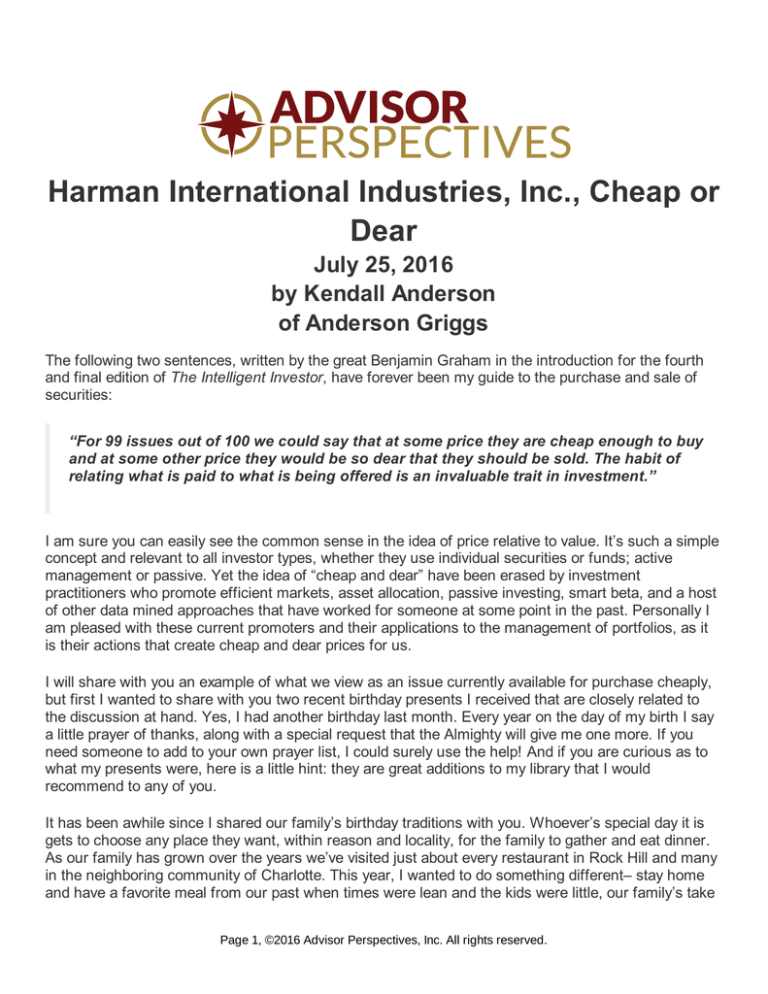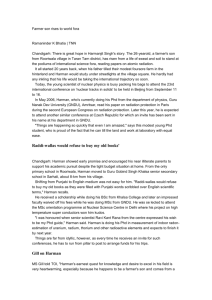
Harman International Industries, Inc., Cheap or
Dear
July 25, 2016
by Kendall Anderson
of Anderson Griggs
The following two sentences, written by the great Benjamin Graham in the introduction for the fourth
and final edition of The Intelligent Investor, have forever been my guide to the purchase and sale of
securities:
“For 99 issues out of 100 we could say that at some price they are cheap enough to buy
and at some other price they would be so dear that they should be sold. The habit of
relating what is paid to what is being offered is an invaluable trait in investment.”
I am sure you can easily see the common sense in the idea of price relative to value. It’s such a simple
concept and relevant to all investor types, whether they use individual securities or funds; active
management or passive. Yet the idea of “cheap and dear” have been erased by investment
practitioners who promote efficient markets, asset allocation, passive investing, smart beta, and a host
of other data mined approaches that have worked for someone at some point in the past. Personally I
am pleased with these current promoters and their applications to the management of portfolios, as it
is their actions that create cheap and dear prices for us.
I will share with you an example of what we view as an issue currently available for purchase cheaply,
but first I wanted to share with you two recent birthday presents I received that are closely related to
the discussion at hand. Yes, I had another birthday last month. Every year on the day of my birth I say
a little prayer of thanks, along with a special request that the Almighty will give me one more. If you
need someone to add to your own prayer list, I could surely use the help! And if you are curious as to
what my presents were, here is a little hint: they are great additions to my library that I would
recommend to any of you.
It has been awhile since I shared our family’s birthday traditions with you. Whoever’s special day it is
gets to choose any place they want, within reason and locality, for the family to gather and eat dinner.
As our family has grown over the years we’ve visited just about every restaurant in Rock Hill and many
in the neighboring community of Charlotte. This year, I wanted to do something different– stay home
and have a favorite meal from our past when times were lean and the kids were little, our family’s take
Page 1, ©2016 Advisor Perspectives, Inc. All rights reserved.
on Salisbury Steak.
Our version of the recipe is a simple one my wife makes out of hamburger and a couple cans of soup,
and it was always paired with the largest bowl of real mashed potatoes ever seen by three youngsters. I
may have secretly just been testing Kathy to see if she still has a little bit of love left for me. You see,
she has been a vegetarian for a decade. Just looking at a pan of raw meat was difficult for her, so
preparing and cooking my favorite dish certainly took a lot of love.
After all these years Kathy still knows what else I truly appreciate, and that is books on investing. She
went out of her way this year and gave me a wonderful book, The Great Minds of Investing. It’s a
special book, filled with beautiful photographs of the great investors taken by Michael O’Brien, and
matched with revealing profiles written by William Green. It is fairly expensive as books go, but would
be a valuable addition to your investment library and look great on the coffee table.
I must admit I also sneakily bought myself a birthday present, another book whose grand total was one
penny. The only drawback on price was that I had to pay an additional $3.99 for shipping and handling.
Even with a total cost of $4.00, I will tell you it was a tremendous bargain. The book is There’s Always
Something to Do: The Peter Cundill Investment Approach, written by Christopher Risso-Gill. Peter
Cundill was one of the greatest deep value investors of all time. I found out about Peter through his
support of The Ben Graham Centre for Value Investing. I learned about this book from Michael Price,
who stated he keeps it close at hand for reference. Given that Michael Price is also known as a great
investor, his recommendation was all I needed to splurge and spend $4.00. I can highly recommend
both books for curiosity seekers and serious students of investing alike.
A Brief Analysis of Harman International Industries, Inc. (HAR)
Harman International designs, manufactures, and markets high-fidelity audio products and electronic
systems through three main operating segments: Infotainment, Lifestyle and Professional. The
Infotainment segment is the largest of the three, generating 51% of sales for the last fiscal year ending
in June. Infotainment may not sound familiar to you, but if you drive any fairly new automobile today
you experience it any time you use the screen in the center of the dash that controls your GPS, traffic
info, Bluetooth devices, voice activated telephones, texting, climate control, multi-seat entertainment,
digital media, wireless internet access, DVD recording and playback, MP3 playback, and safety
features. Historically, Harman has produced these units for the luxury division of auto manufacturers
including Audi/Volkswagen, BMW, Fiat, Chrysler, Toyota, Lexus, Porsche, Daimler AG, GM, Peugeot
Citroen, Hyundai, Kia and Ssangyong.
The company’s Lifestyle division accounts for 31% of sales. This division designs, manufactures and
markets audio systems for vehicle installation as original equipment, as well as producing a large range
of high quality loudspeakers and electronics for other uses. Brand names include JBL, AKG,
Harman/Kardon, Infinity, Mark Levinson, Revel, Logic 7, Lexicon and Selenium. Its home audio
products are sold through specialty audio stores, mass-market retail stores such as Apple, Best Buy,
Target, Media Markt and Fnac, and online retailers including Amazon.com.
The Professional division designs, manufactures, and markets a range of loudspeakers, power
Page 2, ©2016 Advisor Perspectives, Inc. All rights reserved.
amplifiers, digital signal processors, microphones, headphones, mixing consoles, lighting systems and
IDX info delivery services used by audio professionals in concert halls, stadiums, airports, churches
and other public spaces. They are or have been used at the GRAMMY awards, Super Bowl XLVII, the
Oscars, and many other prestigious events around the world.
In fiscal year 2015, 28% of the company sales were in Germany, 31% in the US, 19% in Europe
excluding Germany, and 23% to the rest of the world. Harman employs about 24,000 individuals
around the world.
A few financial facts:
Market Cap: $5.5 Billion
Trailing 12 Month Sales: $6.71 Billion
9 Year Shareholder Equity Growth (Annualized): 7.60%
10 Year Book Value Growth (Annualized): 7.67%
10 Year Dividend Growth Rate (Annualized): 38.73%
10 Year Average ROE: 13.3%
10 Year Average ROIC: 11.76%
Debt/Total Capital: 24%
Trailing Twelve Month Earnings per Share: $6.05
Forward Twelve Month Earnings Estimate at time of purchase: $6.88
Indicated Annual Dividend per share: $1.40
Actual Average Price Paid per share on 6-29-2016: $69.8476
Historical Valuation
With every purchase, the three questions we must provide answers for are:
Page 3, ©2016 Advisor Perspectives, Inc. All rights reserved.
1) Is the company financially sound enough for a conservative investor to buy and hold shares for
an extended period of time?
2) Is the business sustainable and able to grow shareholder equity and earnings in the coming
years?
3) Are the shares available to buy at such a price that the margin of safety is large enough to
protect against potential problems facing the business?
We do consider Harman a financially sound business. We base this on a bit of common sense. If the
business has positive cash flow, meaning enough cash to pay all of its bills and replace or repair worn
out assets, while still having enough left over to invest for the future under severe conditions, then we
have little reason to believe we’ll wake up in the morning and find out the company has filed
bankruptcy. In Harman’s case they produce over $8.00 per share in cash flow, which is more than
enough to pay their bills and grow their business. In addition, they have a limited amount of borrowing,
which lets us know that a banker is not going to knock on the door and foreclose.
We also believe that Harman’s business is sustainable. It is obvious that the bulk of Harman’s
revenues and growth potential are tied to the auto business which is very cyclical. The past few years
since the great recession, auto sales have been booming. The fear for many is that any decline in auto
sales will have a major impact on Harman. This is true except for the fact that auto and truck sales,
even in the worst of economic times, have sold enough to maintain production. Harman can also
increase sales through new and extended production contracts with other auto manufactures. This has
already started with the addition of new contract wins with Toyota and General Motors for non-luxury
vehicles. All cars today must include an appropriate infotainment center or they just won’t sell. For
additional security the other divisions are able to fill the need of music lovers everywhere. Altogether
we do not see the market for Harman’s production failing any time soon.
As far as price, and whether, as Ben Graham would say, Harman is “cheap or dear,” a simple review of
the historical valuation table above that compares share price with trailing earnings is useful in helping
us answer this question. Excluding the years of 2008 through 2010 which have little meaning, the
lowest price to trailing earnings the market valued Harman’s shares prior to the last few months was in
2012 at 11.64 times. At our purchase price on June 29th the market gave us the ability to buy shares
just as cheap at 11.54 times trailing earnings of $6.05.
The current consensus earnings per share over the coming twelve months is $6.88. If the analyst
estimates are in the ball park, then we have purchased shares at slightly above 10 times earnings. No
one can tell the future, but in my humble opinion, Harman is at the price where it is “cheap enough to
buy.”
Until next time,
Kendall J. Anderson, CFA
Anderson
Griggs
& Company,
doingand
business
as Anderson
Investments,
is meets
a registered
investment adviser.
Anderson
Griggs
only
conducts
businessInc.,
in states
locations
where
it isGriggs
properly
registered
or
forafter
advisors.
This our
commentary
is for
only
and is not
an offer
of a
investment
advice.
We
willstate
only requirement
render
advice
weAgreement.
deliver
Formreference
ADV Part
2 performance
toinformational
a client in is
anpurposes
authorized
jurisdiction
and
receive
properly
executed
Investment
Supervisory
Services
Any
to
historical
in
nature
and
no
assumption
about
future
performance
should
be
made
based
onAnderson
the past
performance
of
any
Anderson
Griggs’
Investment
Objectives,
individual
account,
individual
security
or
index.
Upon
request,
Griggs
will are
provide
to you a
list of all
trade recommendations
made
by us
for
the immediately
preceding
12 months.or
The
authorsInvestments
of publications
expressing
general
opinions
and commentary.
They are
not
attempting
to provide
legal, at
accounting,
specific
advice
anySC
individual
their
personal
Anderson
Investments’
office
is
113
E. Main
St.,
Suite
310,
RocktoHill,
29730. concerning
The local phone
number issituation.
803-324-5044
and Griggs
nationally
can be reached
vialocated
its toll-free
number
800254-0874.
Page 4, ©2016 Advisor Perspectives, Inc. All rights reserved.
© Anderson Griggs Investments
Page 5, ©2016 Advisor Perspectives, Inc. All rights reserved.


